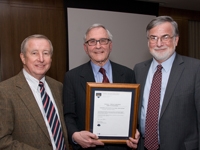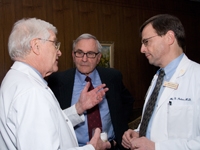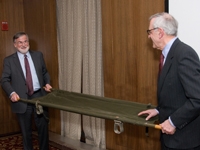As an internal medicine resident at University of Texas Southwestern Medical Center in Dallas, Dr. Mark Pecker had heard of Dr. Ralph Nachman long before he met him.
"I first heard about him abstractly as this giant in the field who could do everything," said Dr. Pecker, vice chairman of educational affairs, program director and professor of clinical medicine at Weill Cornell Medical College.

(From left) Dr. Antonio M. Gotto Jr., Dr. Ralph Nachman, and Dr. Andrew Schafer.
Almost a decade later, Dr. Pecker would find himself leading the intern selection committee for Dr. Nachman, then the chairman of the Department of Medicine at Weill Cornell Medical College.
"I worked pretty closely with him throughout that," Dr. Pecker said, "and everything they said about him was true, but more so. His research accomplishments speak for themselves. He put vascular biology on the map. His papers are the most heavily quoted."
Dr. Nachman served as the chairman of the Department of Medicine at Weill Cornell from 1990 to 2007 and is now associate dean for clinical research and the Lewis Thomas University Professor of Medicine. To honor his remarkable career, the department, on behalf of its chairman Dr. Andrew Schafer, assembled a scientific tribute to its former chief, held Nov. 20 in Uris Auditorium.
Dr. Schafer also announced the creation of the Ralph L. Nachman, M.D., Distinguished Visiting Professorship in the Department of Medicine.
Dr. Herbert Pardes, president and CEO of NewYork-Presbyterian Hospital; Dr. David Hajjar, senior executive vice dean and executive vice provost of the Medical College; and Dr. Orli Etingin, director of the Iris Cantor Women's Health Center, introduced Dr. Nachman at the tribute.
"Whatever he goes into, he ends up as the president or chair," Dr. Pardes said. "He is a natural, distinguished leader."
Dr. Etingin first met Dr. Nachman in the early 1980s; she was a hematology resident and Dr. Nachman was her attending.
"He has this incredible ability to use basic scientific information and weave it together with clinical cases," Dr. Etingin said. "It was very inspiring to me as a resident. He is an amazing clinician but also a scientist. I wanted to be able to learn clinical medicine from him. He taught 'bench to bedside' long before translational medicine was a catchphrase."
In the winter of 1990, Dr. Nachman, then the director of the Division of Hematology-Oncology, was named the chairman of medicine and its physician-in-chief.

(From left) Dr. E. Darracott Vaughan, Dr. Nachman and Dr. Mark Pecker.
"Being asked to be the chair of the Department of Medicine is no fluff job," Dr. Hajjar said. "You really have to have made your mark as a scientist."
A native of Bayonne, N.J., Ralph Nachman received both his undergraduate and medical degrees from Vanderbilt University in Nashville, Tenn. He first came to what was then called New York Hospital later that year as a pathology resident. In 1958, he left the Hospital to fulfill his military obligation, serving as a physician in the U.S. Navy. After completing his residency at Montefiore Hospital, Dr. Nachman returned to New York Hospital and Cornell University Medical College in 1962 to pursue a research fellowship.
Just one year later, he was appointed director of laboratories for clinical pathology at the Hospital and became a Medical College faculty member as an instructor in medicine. Dr. Nachman was named director of the Division of Hematology in 1968 and made professor of medicine in 1972. In 1979, he served as the co-director of the joint M.D.-Ph.D. program.
Dr. Nachman has previously served as vice chairman, acting chairman and acting co-chairman of the Department of Medicine.
For two years, 1987 to 1989, he served as a member of the Board of Overseers, representing the faculty of the Medical College.
At the time of his appointment to the chairmanship in 1990, then-dean Dr. G. Tom Shires said, "Dr. Nachman's achievements as a researcher and academician, as well as his commitment to medical education, will ensure that the Medical College continues its leading role in physician training and biomedical research."

With the help of Dr. Schafer (left), Dr. Nachman, an avid Yankees fan, unveils a gift from the Department of Medicine — an official Yankees-Steiner stretcher.
"He was a very well-respected scientist who was suddenly thrust into a chairmanship," remembered Dr. E. Darracott Vaughan, chairman emeritus of the Department of Urology and the James J. Colt Professor of Urology at Weill Cornell. "He very quickly picked up the management and changing business aspects that were going on at the time. He realized there was a need for internal medicine and refocused the residency training so you could have of the option of patient care or academics. That was a bit of a surprise for someone who had primarily worked in research."
While Dr. Nachman deftly balanced the scientific, clinical and political roles of his career, Dr. Etingin remembers him as a man who was reluctant to embrace the more social aspect of his responsibilities.
"Over the course of all of his years, Dr. Nachman had to attend all these various dinners and grand rounds and commemorative events, and sometimes there were black-tie events during the week," Dr. Etingin said. "And there was nobody like Ralph who could be present at one of those and still be out the door by 8 o'clock. It's often a joke that when we see someone leaving one of these functions early that they're 'pulling a Nachman.'"
Photography by Amelia Panico.

